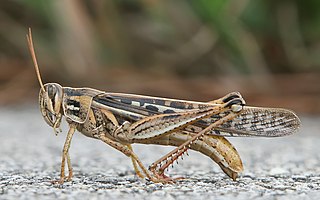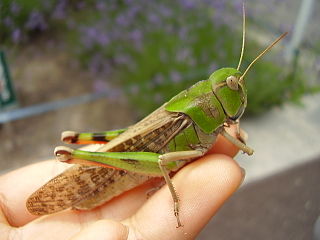
Locusts are various species of short-horned grasshoppers in the family Acrididae that have a swarming phase. These insects are usually solitary, but under certain circumstances they become more abundant and change their behaviour and habits, becoming gregarious. No taxonomic distinction is made between locust and grasshopper species; the basis for the definition is whether a species forms swarms under intermittently suitable conditions; this has evolved independently in multiple lineages, comprising at least 18 genera in 5 different acridid subfamilies.

The desert locust is a species of locust, a periodically swarming, short-horned grasshopper in the family Acrididae. They are found primarily in the deserts and dry areas of northern and eastern Africa, Arabia, and southwest Asia. During population surge years, they may extend north into parts of western Spain and southern Italy, south into Eastern Africa, and east in northern India. The desert locust shows periodic changes in its body form and can change in response to environmental conditions, over several generations, from a solitary, shorter-winged, highly fecund, non-migratory form to a gregarious, long-winged, and migratory phase in which they may travel long distances into new areas. In some years, they may thus form locust plagues, invading new areas, where they may consume all vegetation including crops, and at other times, they may live unnoticed in small numbers.

The migratory locust is the most widespread locust species, and the only species in the genus Locusta. It occurs throughout Africa, Asia, Australia and New Zealand. It used to be common in Europe but has now become rare there. Because of the vast geographic area it occupies, which comprises many different ecological zones, numerous subspecies have been described. However, not all experts agree on the validity of some of these subspecies.

The red locust is a large grasshopper species found in sub-Saharan Africa. Its name refers to the colour of its hind wings. It is sometimes called the criquet nomade in French, due to its nomadic movements in the dry season. When it forms swarms, it is described as a locust.

Schistocerca nitens is a species of grasshopper known by several names, including vagrant grasshopper and gray bird grasshopper. It is a close relative of the desert locust, which is in the same genus. This grasshopper is native to southern North America including Mexico and the south-western United States from California to Texas. Vagrants are occasionally found in Colorado and Nebraska, where the climate is too cold for them to reproduce, otherwise. It is also present in parts of Central and South America. It lives in many habitats including desert, woodland, and lower elevation mountainous areas. It is a large grasshopper, reaching lengths of 4 to 7 centimeters. It is mostly brown and gray spotted or patched in cryptic coloration. This species is known as a pest on ornamental plants and many types of crop plants.

Schistocerca is a genus of grasshoppers, commonly called bird grasshoppers, many of which swarm as locusts. The best known species is probably the desert locust and trans-Atlantic flight may explain the biogeography of some locust species.

The Australian plague locust is a native Australian insect in the family Acrididae, and a significant agricultural pest.

The Senegalese grasshopper is a medium-sized grasshopper species found in the Sahel region of Africa, the Canary Islands, Cape Verde Islands, and West Asia. Although not called a locust in English, this species shows gregarious behaviour and some morphological change on crowding. In many parts of the Sahel, this species may cause greater year-on-year crop damage than better-known locusts, attacking crops such as the pearl millet.

The brown locust is a medium-sized small locust species in the monotypic genus Locustana. It is found in Southern Africa and shows classic gregarious behaviour with phase polymorphism on crowding.

Dociostaurus maroccanus, commonly known as the Moroccan locust, is a grasshopper in the insect family Acrididae. It is found in northern Africa, southern and eastern Europe and western Asia. It lives a solitary existence but in some years its numbers increase sharply, and it becomes gregarious and congregates to form swarms which can cause devastation in agricultural areas. The species was first described by Carl Peter Thunberg in 1815.

Calliptamus italicus, the Italian locust, is a species of 'short-horned grasshopper' belonging to the family Acrididae, subfamily Calliptaminae.

Schistocerca americana is a species of grasshopper in the family Acrididae known commonly as the American grasshopper and American bird grasshopper. It is native to North America, where it occurs in the eastern United States, Mexico, and the Bahamas. Occasional, localized outbreaks of this grasshopper occur, and it is often referred to as a locust, though it lacks the true swarming form of its congener, the desert locust.

Valanga nigricornis, the Javanese grasshopper, is a species of grasshopper in the subfamily Cyrtacanthacridinae of the family Acrididae. It is found in southeastern Asia, the type location being Singapore. It was first described by the German zoologist Hermann Burmeister in 1838. There are more than twenty subspecies, most of which are endemic to different island groups; the subspecies V. nigricornis nigricornis is the type for the genus Valanga.

Locusta migratoria manilensis, commonly known as the Oriental migratory locust, is a subspecies of the migratory locust in the family Acrididae. It is sufficiently different in size and structure from the African migratory locust to be considered a distinct subspecies of the migratory locust. It is found in southeastern Asia and is an important agricultural pest in the region. It is normally a solitary insect but when conditions are suitable, it enters into a gregarious phase when the young form into bands which move together and the adults into swarms. Although outbreaks may have recently been fewer in number and size because of changes in agricultural practices and better locust detection, the insects remain active as crop pests and the potential for outbreaks is still present.

Locusta migratoria migratorioides, commonly known as the African migratory locust, is a subspecies of the migratory locust family Acrididae.

The Cyrtacanthacridinae are a subfamily of Orthoptera: Caelifera in the family Acrididae. They are sometimes referred-to as bird locusts, criquets voyageurs in French-speaking Africa, and Knarrschrecken in German.

Schistocerca cancellata is a species of locust in the subfamily Cyrtacanthacridinae. It is the major swarming species in subtropical South America. This species shows typical locust phase polymorphism. Solitarious nymphs are green, but gregarious ones are yellow with a black pattern. There are morphological differences between solitarious and gregarious adults. For many years the two phases were believed to be different species and the gregarious form was mistakenly identified as S. paranensis. The solitary phase is found in South America between 18°S and 35°S. Plagues originate in a desert and semi-desert zona permanente in NW Argentina, SE Bolivia and W Paraguay, when good rains allow successful breeding, followed by gregarisation. Swarms of gregarious adults may then migrate into crop growing regions.

Schistocerca pallens is a large “bird grasshopper” in the subfamily Cyrtacanthacridinae that occurs throughout tropical America. It is closely related to Schistocerca cancellata but shows no swarming behaviour or locust phase polymorphism, even under crowded laboratory conditions. Although not a swarming locust, it can occur at sufficiently high densities to cause economic damage. It is mainly a pest of sugar cane, but has also been recorded as damaging almond, banana, beans, breadfruit, carnauba wax palm, chickpeas, coconut palms, cotton, forage crops, groundnuts, indigo, legumes, maize, onions, rice, sorghum, sweet potato and tomatoes.

2019–2022 locust infestation is a pest outbreak of desert locusts which is threatening the food supply across the regions of East Africa, the Arabian Peninsula, and the Indian subcontinent. The outbreak is the worst in 70 years in Kenya and the worst in 25 years in Ethiopia, Somalia, and India. The plague began in June 2019. As of November 2020, swarms were primarily found in the Horn of Africa and Yemen.


















